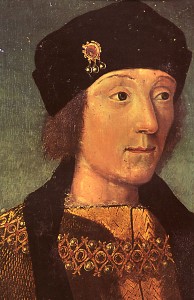 On this day in 1485, the founder of the Tudor dynasty, Henry Tudor, was crowned King Henry VII at Westminster Abbey. The Tudor chronicler, Raphael Holinshed, recorded:
On this day in 1485, the founder of the Tudor dynasty, Henry Tudor, was crowned King Henry VII at Westminster Abbey. The Tudor chronicler, Raphael Holinshed, recorded:
“…with great pompe he rowed unto Westminster, & there the thirtith daie of October he was with all ceremonies accustomed, anointed, & crowned king, by the whole assent as well of the commons as of the nobilitie, & called Henrie the seaventh of that name: which was in the yeare of the world 5452, and after the birth of our Lord 1485, in the fortie and sixt yeare of Frederike the third then emperour of Almaine, Maximilian his sonne being newlie elected king of the Romans, in the second yeare of Charles the eight then king of France, and in the fiue and twentith of king James then ruling the realme of Scotland.
His biographer, Thomas Penn, describes how this was the occasion that Henry was united with his mother, Lady Margaret Beaufort, whom he’d not seen for fourteen years. Margaret was said to have “wept marvellously”.
Henry was the first Tudor monarch and had claimed the crown of England after defeating Richard III at the Battle of Bosworth Field on the 22nd August 1485. He had actually been unofficially crowned with Richard’s crown on the battlefield that day.
On the 18th January 1486, Henry united the Houses of Lancaster and York by marrying Elizabeth of York, a move which strengthened his monarchy and his future offsprings’ claims to the throne. Henry VII reigned until his death on 21st April 1509, when he was succeeded by his son Henry VIII.
Notes and Sources
- Holinshed’s Chronicle (1587 edition), Volume 6, p762
- Winter King: Henry VII and the Dawn of Tudor England, p11
- On this Day in Tudor History, Claire Ridgway
Henry VII is often credited with having stopped the Wars of the Roses. However, they would have been counted as stopped in 1471 had he not come along and started them up again in 1485. Bosworth was not the last battle; there was the battle of East Stoke in June 1487. After that battle Henry VII continued to have pretenders make attempts on the throne. He didn’t really have any peace during his whole reign. When it was thought he might die leaving the child Henry as his heir the remaining Yorkist nobility did not consider Henry as successor; “none spoke of my lord prince”. Henry VIII was the natural successor because he was old enough not to need a regency.
The coronation appears to have been well attended and with all the normal ceremonial of any coronation, not the small affair that Dan Jones has claimed in his recent book. Hail Henry, Son of Prophecy! Margaret must truly have been relieved to finally see her son, for whom she had spent all of her hopes safe and on the throne that she had forseen for him and worked for him since his birth. Actually Henry was more the son of good fortune than prophecy with the narrow escapes and preservations during his life; but now he had become King, he would have to work to keep it, with the final battle being the Battle of Stoke but he would face pretenders until 1497. Then he would rule in peace and his son would be the first son to come to the throne without threat in nearly 100 years. His best memorial is the propaganda that Henry VIII reveals to him in the Whitehall mural that shows Henry and Elizabeth of York and Henry and Jane Seymour and his ideal family, in this he states that Henry ended the wars of the roses; but that he brought England out of darkness; the son is greater than the father. Certainly Tudor propaganda was born on the field of Bosworth.